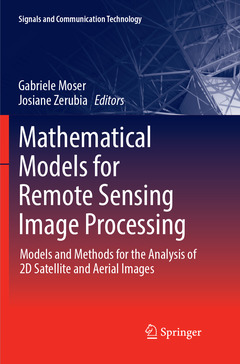Description
Mathematical Models for Remote Sensing Image Processing, Softcover reprint of the original 1st ed. 2018
Models and Methods for the Analysis of 2D Satellite and Aerial Images
Signals and Communication Technology Series
Coordinators: Moser Gabriele, Zerubia Josiane
Language: English
Subjects for Mathematical Models for Remote Sensing Image Processing:
Publication date: 09-2018
Support: Print on demand
Publication date: 12-2017
Support: Print on demand
Description
/li>Contents
/li>Biography
/li>Comment
/li>
This book maximizes reader insights into the field of mathematical models and methods for the processing of two-dimensional remote sensing images. It presents a broad analysis of the field, encompassing passive and active sensors, hyperspectral images, synthetic aperture radar (SAR), interferometric SAR, and polarimetric SAR data. At the same time, it addresses highly topical subjects involving remote sensing data types (e.g., very high-resolution images, multiangular or multiresolution data, and satellite image time series) and analysis methodologies (e.g., probabilistic graphical models, hierarchical image representations, kernel machines, data fusion, and compressive sensing) that currently have primary importance in the field of mathematical modelling for remote sensing and image processing. Each chapter focuses on a particular type of remote sensing data and/or on a specific methodological area, presenting both a thorough analysis of the previous literature and a methodologicaland experimental discussion of at least two advanced mathematical methods for information extraction from remote sensing data. This organization ensures that both tutorial information and advanced subjects are covered. With each chapter being written by research scientists from (at least) two different institutions, it offers multiple professional experiences and perspectives on each subject. The book also provides expert analysis and commentary from leading remote sensing and image processing researchers, many of whom serve on the editorial boards of prestigious international journals in these fields, and are actively involved in international scientific societies. Providing the reader with a comprehensive picture of the overall advances and the current cutting-edge developments in the field of mathematical models for remote sensing image analysis, this book is ideal as both a reference resource and a textbook for graduate and doctoral students as well as for remote sensing scientists and practitioners.
Gabriele Moser received the laurea (M.Sc. equivalent) degree in telecommunications engineering, and the Ph.D. degree in space sciences and engineering from the University of Genoa, Italy, in 2001 and 2005, respectively. Since 2014, he has been an associate professor of telecommunications at the University of Genoa. Since 2001, he has cooperated with the Image Processing and Pattern Recognition for Remote Sensing laboratory of the University of Genoa. Since 2013, he has been the Head of the Remote Sensing for Environment and Sustainability laboratory at the Savona Campus of the University of Genoa. From January to March 2004, he was a visiting student at INRIA, Sophia Antipolis, France. In 2016, he spent a period as visiting professor at the National Polytechnic Institute of Toulouse, France. From 2012 to 2016, he was an external collaborator of the Ayin laboratory at INRIA, Sophia Antipolis, France.
He is co-author of more than 150 scientific publications in journals, international edited books, and conference proceedings. His research activity is focused on pattern recognition and image processing methodologies for remote sensing and energy applications.He has been a Senior Member of the IEEE since 2014. He received the “Alessandro and Rinaldo Viviani 2002” laurea thesis award issued by the Italian Electrical and Electronic Association, the Best Paper Award at the 2010 IEEE Workshop on Hyperspectral Image and Signal Processing, and the Interactive Symposium Paper Award at the 2016 IEEE International Geoscience and Remote Sensing Symposium (IGARSS 2016).
He has been an area editor of Pattern Recognition Letters (PRL) since 2015, and an associate editor of the IEEE Geoscience and Remote Sensing Letters since 2008. He was an associate editor of PRL from 2011 to 2015, and guest co-editor of the September 2015 special issue of the IEEE Geoscience and Remote Sensing Magazine. He served as chairman of the Image Analysis andData
These books may interest you

Polarimetric Microwave Imaging 179.34 €



